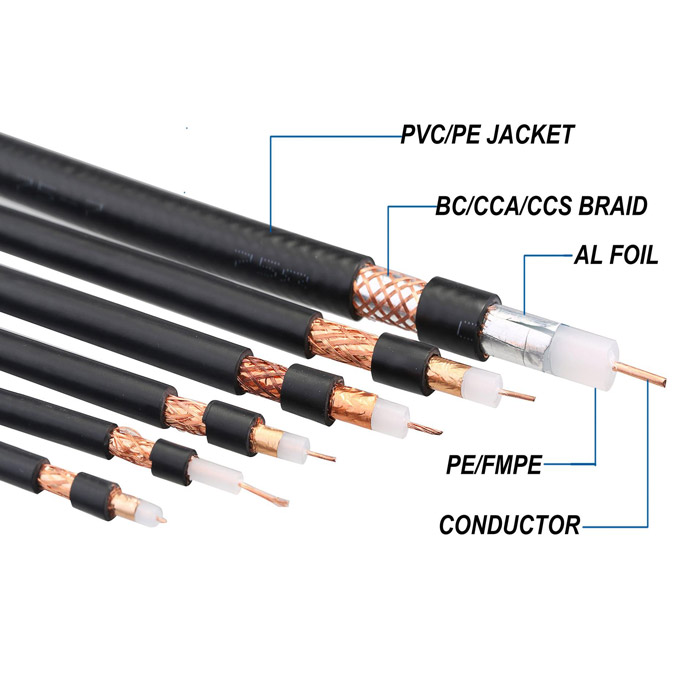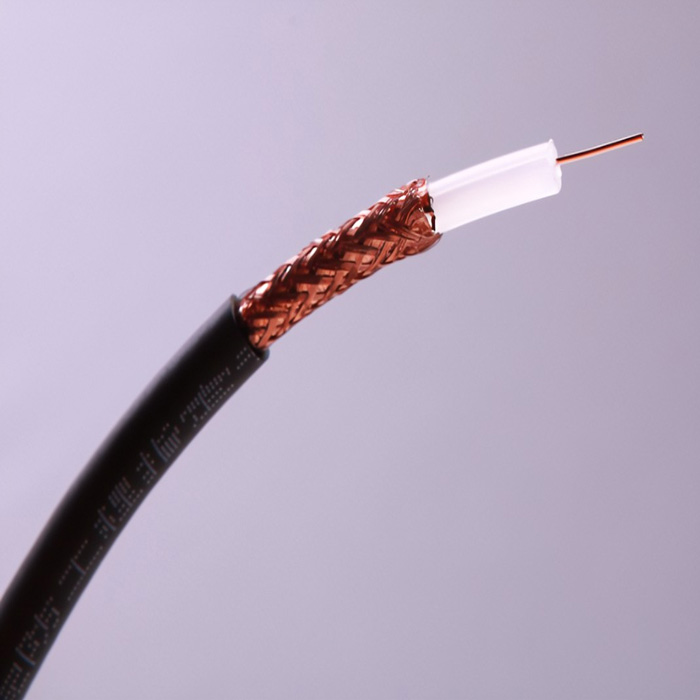Satellite TV can reach the most remote corners of the earth, where there are no usual providers and broadcast towers. The available compact systems can be installed anywhere. The satellite dish provides it with color and a clear picture. The common cable used for satellite TV is satellite coaxial cable.
Reliable reception depends on the setup and technical equipment. With cables, it is possible both to improve and maintain quality indicators and to reduce the potential for wrong choices.
So how should you choose a satellite cable and how to check it before you buy it? Let ZMS cable company’s editor take you through satellite cables.
What is Satellite Coaxial Cable?
Satellite coaxial cable is a two-conductor consisting of an inner conductor and a shielding network.
Since the axes of these two conductors overlap, it is called a coaxial cable or coaxial line.
Satellite coaxial cable contains four parts: inner conductor copper core, insulator, metal shielding network and aluminum composite film, and sheath.
The inner conductor copper core is a solid core conductor.
The insulator is made of polyethylene, which has low dielectric loss and good engineering performance.
Metal shielding network and aluminum composite film, together to complete the role of shielding and external conductivity. The aluminum composite film mainly completes the role of shielding, while the metal shielding network completes the dual role of shielding and external conductivity.
The sheath is to slow down the aging of the cable and avoid damage.
Satellite Coaxial Cable Characteristics
The important transmission characteristic of satellite coaxial cable is that the higher the frequency, the greater the attenuation.
If the cable core is too thin and the shielding network is too thin, the leakage and attenuation of the signal increase, thus causing the degradation of the signal quality.
As an electrical signal conductor, the product has technical and physical characteristics.
The laws of electrical engineering state that the AC is mainly distributed on the surface of the conductor. The smallest potential is near the center.
Stoga, the thicker the cable conductor, the smaller the attenuation of the influence range. The standard diameter of the TV antenna centerline: is 0.5-1 mm.
Anti-wave
The unit of measurement for energization is the ohm. For TV and satellite cables, 75 ohms is generally used.
This is the input impedance of the connector to which the cable is connected. Inconsistencies in the numbers will result in a reduction of the current potential.
In the absence of equal wire resistance, connections can be made with different characteristics over short distances. For example, in private homes.
Satellite Coaxial Cable option
A satellite cable is an outdoor device. Part of the cable route needs to be laid in open areas. So how choosing coaxial cable is important.
1 Outer Sheath Material
It is recommended to choose the cable made of polyethylene base material. This is because it is not easily affected by complicated factors, such as bad weather or extreme temperature. For example, bad weather or extreme temperature, itd. PVC material will keep the cable from cracks caused by cold outdoors because the cold will destroy the cable insulation.
Specifically, cold moisture gets inside the cable and causes a short circuit. The equipment will then malfunction. Choose coaxial cables with special impregnation for harsh conditions when purchasing.
2 Internal Insulation Structure
Satellite broadcasting has propagation characteristics, so it requires a direct line of sight between the radiation source and the cable. Swaying tree branches on the road, nearby wire structures, and intensive rainfall and snowfall can cause a lot of trouble for outdoor cables. So it is important to maintain the existing signal reception and bring it to the receiver.

In addition to TV signals, converter control commands should be transmitted through the cable. So you should choose a product with a double-layer inner network, such as braided coaxial, with a layer of aluminum foil.
3 Cable Bending Resistance
Satellite coaxial cables are rarely laid in a straight line when laid. Stoga, the cable needs to be selected taking into account whether the cable will break easily after bending.
4 Comparison of Cables
Under the same circumstances, thick cables are superior to thin cables. Physical foam cable is superior to solid cable. The high braided cable is better than the low braided cable. Copper-core cable is better than copper-clad steel cable. Copper braided network cable is superior to aluminum-magnesium alloy cable.
At present, the commonly used satellite coaxial cable is type 75-5. For the receiving system with long transmission lines, the interference-resistant coaxial cable should be used.
It is a double-insulated and double-shielded coaxial cable. Its core, insulation, and shield are still the standard 75-ohm cable.
But the difference is that the second layer of insulation and the second layer of shielding are added to the original shielding layer. And the sheath is added on the outside, so it has excellent anti-interference performance.
Satellite Coaxial Cable Installation
Experienced experts say that electricity is a science that can be touched. If you are not careful when installing the cable, it will not work or even be dangerous. So how to install the cable is very important.
1 If the receiver is 10-15 meters from the satellite cable, you can buy a ready-made sample of the cable with connectors. Connector F contacts are placed at the end of the cable.
For example, the RG-6 cable means that it is suitable for RF cables with an external insulation diameter of 6 mm.
2 Before buying the cable, find out the length of the cable needed, and the section where laying is difficult.
3 Avoid bending into sharp angles when laying to prevent breakage.
4 When laying, when ripping out from the wall to the street, makes a downward loop of the cable. This way, rainwater will drip downward when it rains instead of draining down the shell into the hole.
5 When installing through a wooden window frame, drill a channel with a diameter larger than the thickness of the cable.
6 In the case of plastic frames, it is recommended not to perforate. You can use the gap between the window and the wall, filled with polyurethane foam.
7 If installed in a room, the cable can be concealed in a plastic box or skirting board with a cable channel.
8 Do not lay the cable together with other cables. If close to powerful devices and equipment, it may become a source of the interference with satellite coaxial cables.
9 Seal the exit point to an open area. In windy conditions, the lines on the external vertical surface should not sag and swing freely.
Satellite coaxial cable inspection
Check the integrity of the cable after installation is complete. Look for degradation of image quality, screen rippling color bars or picture splitting into small squares, distorted sound, itd.

1 Disconnect the cable from the hinge point closest to the room.
2 Remove the connector through the shield and center conductor.
3 Prepare the equipment used to measure resistance.
4 Check the wiring toward the antenna. Connect the test leads to the center core and metal sheath.
Be careful not to touch the conductor. If the core is in good condition, the device will display a value of not 1, but not 0.
When off, the reading will tend to zero or show 0 and an audible signal will appear. Again, when checking the cable to the room, the cable must be connected to the receiver.
The above is the introduction and selection of satellite coaxial cable. ZMS cable manufacturer is committed to providing a wide range of high-quality cables, with strict manual qualification audits for products and considerate service to customers. High professionalism in cable manufacturing and trustworthy products.


